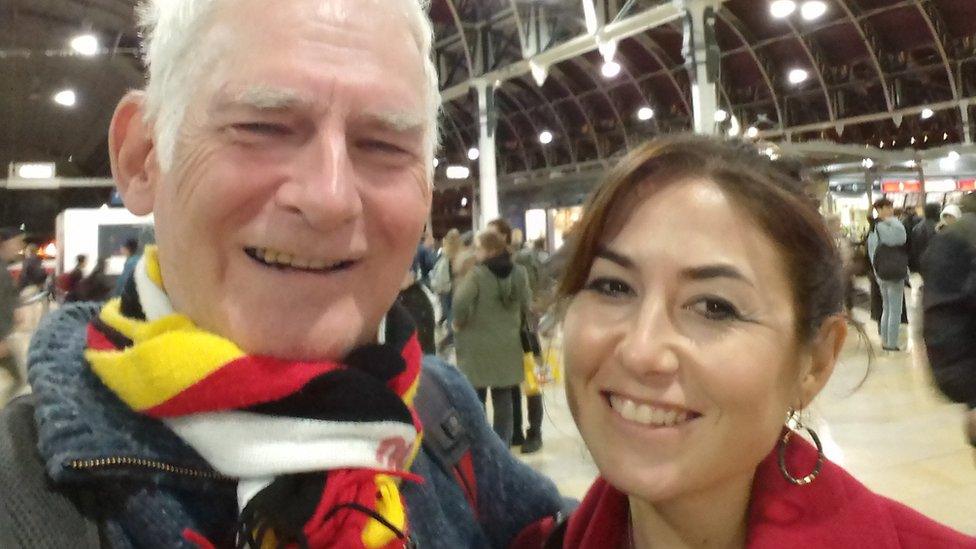Boeing's 'culture of concealment' to blame for 737 crashes
- Published

Two fatal crashes of Boeing 737 Max aircraft were partly due to the plane-maker's unwillingness to share technical details, a congressional investigation has found.
It blames a "culture of concealment" at Boeing, but says the regulatory system was also "fundamentally flawed".
Boeing said it had "learned many hard lessons" from the accidents.
But families of the victims accused the company and the regulator of continuing to hide information.
The US report, external is highly critical of both Boeing and the regulator, the Federal Aviation Administration (FAA).
"Boeing failed in its design and development of the Max, and the FAA failed in its oversight of Boeing and its certification of the aircraft," the 18-month investigation concluded.
The Boeing 737 Max has been grounded since March 2019 after two crashes, in Indonesia and Ethiopia, caused the deaths of 346 people.
The nearly 250-page report found a series of failures in the plane's design, combined with "regulatory capture", an overly close relationship between Boeing and the federal regulator, which compromised the process of gaining safety certification.
"[The crashes] were the horrific culmination of a series of faulty technical assumptions by Boeing's engineers, a lack of transparency on the part of Boeing's management, and grossly insufficient oversight by the FAA."


"Cost-cutting… that jeopardised the safety of the flying public", a "culture of concealment" over issues with the aircraft, "troubling mismanagement misjudgements" - just a snapshot of the stinging charges against Boeing.
But the US aviation regulator, the FAA, comes off almost as badly. US representatives find it guilty of "inherent conflicts of interest" and "grossly insufficient oversight".
More seriously, they say the regulator was, in effect, in Boeing's pocket and that the FAA's management "overruled" its own technical and safety experts "at the behest of Boeing".
Boeing admits "mistakes were made" and it now wants to focus on getting the 737-Max back in the air, saying the "revised design" of the aircraft has been "thoroughly scrutinised".
Regulators in Europe and the US are relatively close to recertifying the 737-Max. But this is one of the biggest safety scandals facing a private company in modern times.
And other investigations are outstanding, including a giant lawsuit from the relatives of those killed in the second crash in Ethiopia.

Boeing said it had made, external "fundamental changes" to the company as a result of the accidents.
The FAA said it would work with lawmakers to "implement improvements identified in the report".
The report said Boeing had failed to share information about a key safety system, called MCAS, designed to automatically counter a tendency in the 737 Max to pitch upwards. Boeing was at fault for "concealing the very existence of MCAS from 737 pilots", it found.
MCAS was not in crew manuals and Boeing sought to convince regulators not to require simulator training for Max pilots, which would incur extra costs.
The MCAS system has been blamed for both crashes that came within months of each other, shortly after the plane went into operation.
'Halt the process'
"The FAA should immediately halt the recertification process for the 737 Max in light of this report," said Michael Stumo, whose daughter Samya Rose Stumo died in the Ethiopian crash in March 2019.
"The FAA and Boeing hid information before and are doing it again," he added.
"Both Boeing and the FAA have refused to provide their data that support their efforts to unground the plane. The Max should not fly until Boeing and the FAA provide this data, so independent experts and the public can confirm the aircraft is safe."

Zipporah Kuria says: We need to axe the Max
British national Zipporah Kuria, whose father was killed in the same crash, said it would be "grossly irresponsible" to recertify the 737 Max.
"My heart is shattered. My dad lost his life and I lost him," she said
"If I'd lost him because of a faulty sensor, I may have come to accept it as an incident, but I lost my dad to greed, corruption and lack of human decency.
"This is why we need to axe the Max. The public shouldn't continue bearing the cost for corner-cutters who do not seem to have a conscience."
'Captured' regulator
Paul Njoroge of Canada, whose entire family was killed on their trip to Kenya to visit grandparents, said the report documented "clear dereliction of duty by Boeing and the FAA in the design and certification process of the 737 Max".
"It is, therefore, clear that at Boeing, safety comes after cost-cutting, profit-maximisation and share price pumpage," he added.
"Further, the report has undoubtedly cast the FAA as a 'captured' regulator - the FAA is therefore an agency promoting Boeing and the industry, instead of promoting the safety of the flying public."
Regulators around the world are currently putting the modified 737 Max through its paces.
The FAA began test flights in June, while the European Union Aviation Safety Agency (EASA) started its own testing programme earlier this month.
EASA has maintained that clearance by the FAA will not automatically mean the plane is considered airworthy in Europe.
"Once the FAA and other regulators have determined the Max can safely return to service, it will be one of the most thoroughly scrutinised aircraft in history, and we have full confidence in its safety," Boeing said.
- Published29 June 2020

- Published10 March 2020

- Published27 August 2020

- Published4 August 2020

- Published20 August 2020
